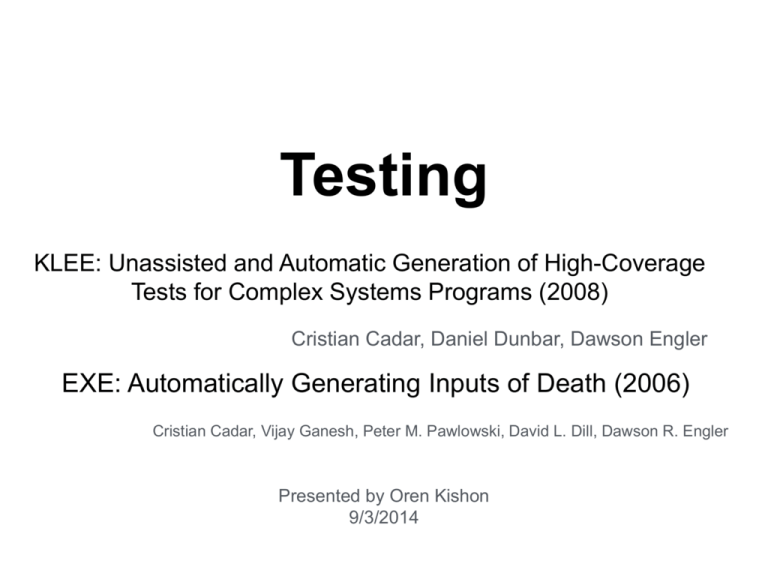Presentation 4
advertisement

Testing
KLEE: Unassisted and Automatic Generation of High-Coverage
Tests for Complex Systems Programs (2008)
Cristian Cadar, Daniel Dunbar, Dawson Engler
EXE: Automatically Generating Inputs of Death (2006)
Cristian Cadar, Vijay Ganesh, Peter M. Pawlowski, David L. Dill, Dawson R. Engler
Presented by Oren Kishon
9/3/2014
Agenda
•
Testing: Introduction
•
KLEE + STP: Technical details
•
Evaluation
•
Related work
•
Summary
•
Discussion
Agenda
•
Testing: Introduction
•
KLEE + STP: Technical details
•
Evaluation
•
Related work
•
Summary
•
Discussion
Testing
•
Purpose :
•
Verifying functional correctness (vs. spec)
•
Verifying software completeness - no crashes,
memory leaks, assert violations…
Testing
•
Purpose :
•
Verifying functional correctness (vs. spec)
•
Verifying software completeness - no crashes,
memory leaks, assert violations…
Testing: example
•
•
Manual test creation: build test with input 6
Large number of fail paths?
• QA person works long hours…
• Test auto-generation
Random input test generation
•
•
✔︎ Much more tests generated than manually
✘ Error path distribution is not uniform: Boundary
values, zero-division…
Back to example: y being a 32 bit int
Symbolic execution
y is symbolic: y = s
y = 2 * s // still symbolic
Fork execution, add constraints
to each path
true path constraint: 2*s==12
Need constraint solver
Constraint solver
2 * s == 12
CNF: ¬s1 ∧ ¬s2 ∧ ¬s3 ∧ ¬s4 ∧ s5 ∧ s6 ∧ ¬s7 ∧ ¬0
SAT solver:
satisfiable? -> asserts
instance -> test generate
2*s
12
s1s2s3s4s5s6s70
00001100
00000010
s0s1s2s3s4s5s6s7
00001100
KLEE: symbolic executer
•
Architecture: compiles C code to LLVM byte code.
Executes a symbolic interpreter.
•
Map LLVM instructions to constraints. Constraint
solver: STP.
•
generates executable tests, independent of KLEE.
•
Used to check all GNU Coreutils and covered 90%
lines: more than 15 year on-going manual test suite
- in 89 hours.
Introduction
•
Before technical details - any questions?
Agenda
•
Testing: Introduction
•
KLEE + STP: Technical details
•
Evaluation
•
Related work
•
Summary
•
Discussion
•
Symbolic execution a deeper look
a deeper look
Definition: execution state
•
Line number
•
values of variables (symbolic/concrete): x=s1,
y=s2+3*s4
•
Path Condition (PC): conjunction of constraints
(boolean formulas) over symbols:
s1>0 ∧ α1+2*s2>0 ∧ ¬(s3>0)
Symbolic Execution and Program Testing
JC King - 1976
•
Symbolic execution a deeper look
a
deeper
look
Execute assignment: evaluate RHS symbolically,
assign to LHS as part of the the state.
•
•
Execute IF (r) / then / else: fork
•
then: PC ⟵ PC ∧ r
•
else: PC ⟵ PC ∧ ¬r
Termination: solve constraint (supply values for
symbols, for test generation)
Symbolic Execution and Program Testing
JC King - 1976
Execution tree
Execution tree properties
•
For each satisfiable leaf exists a concrete input for
which the real program will reach same leaf ⇒
can generate test
•
PC's associated with any two satisfiable leaves are
distinct ⇒ code coverage.
Symbolic Execution and Program Testing
JC King - 1976
KLEE - usage
Compile C programs to LLVM byte code and run KLEE
interpreter with wanted parameters:
$ llvm-gcc --emit-llvm -c tr.c -o tr.bc
$ klee --max-time 2 --sym-args 1 10 10
--sym-files 2 2000 --max-fail 1 tr.bc
KLEE - symbolic execution:
tr (Minix)
3 symbolic arguments
Fork execution
Fork, constraint arg[0]==‘[‘
Detect bug (implicit array bounds checking)
and generate test: input={“[“, “”, “”}
all 37 paths in 2 minutes
KLEE architecture
•
Execution state:
•
Instruction pointer
•
Path condition
•
Registers, heap and stack objects
•
Above objects refer to trees of symbolic expressions.
•
Expressions are of C language: arithmetic, shift, dereference,
assignment…
•
checks inserted at dangerous operations: division, dereferencing
STP - constraint solver
•
A Decision Procedure for Bit-Vectors and Arrays
•
“Decision procedures are programs which determine
the satisfiability of logical formulas that can express
constraints relevant to software and hardware”
•
STP uses new efficient SAT solvers.
STP - constraint solver
•
Treat everything as bit vectors - no types.
•
Expressions on bit vectors: arithmetic (incl. non
linear), bitwise operations, relational operations.
•
All formulas are converted to DAGs of single bit
operations (node for every bit!)
STP
DAG creation
Query optimizations
•
Constraint solver dominates run time (NP-complete
problem in general…)
•
Can pre-process calls to solver to make query
easier
•
Two complicated optimizations (presented next) and
other basic ones (later on)
Query optimizations
Constraint independence
•
Partition constraint set according to symbols
•
Call solver with relevant subset only
•
Example: {i < j, j < 20, k > 0}. a query of whether i = 20 just
requires the first two constraints
Query optimizations
Counter example cache
•
Cache results of previous constraint solver results
•
If constraint set C has no solution and C ⊆ C’, then neither does C’
•
If constraint set C has solution s and C’ ⊆ C, then C’ has solution s
•
If constraint set C has solution s and C ⊆ C’, then C’ likely has
solution s
State choosing heuristics:
•
A big challenge of symbolic executing: path
explosion
•
Can’t cover all paths: need to choose wisely
•
Use different choosing heuristic at each selection
(using round robin)
State choosing heuristics:
Random Path
Selection
•
Maintain binary tree of paths
•
When branch reached, traverse randomly from root
to select state to execute
•
Done to prevent starvation caused by large subtrees
(i.e loops with symbolic condition)
State choosing heuristics:
Coverage-optimize search
•
Compute state weight using:
•
Minimum distance to an uncovered instruction
•
Call stack of the state
•
Whether the state recently covered new code
Environment modeling
•
Another big challenge of symbolic executing:
symbolizing file systems, env. variables, network
packets, etc.
•
KLEE’s solution: model as much as you can.
modeling means to costumize code of system calls
(e.g. open, read, write, stat, lseek, ftruncate, ioctl):
2500 lines of modeling code.
Environment modeling
•
File system examples
•
Read concrete file with symbolic offset: read() is
wrapped with pread()
•
Open symbolic file-name:
•
Program was initiated with a symbolic file system with up to N files
(user defined).
•
Open all N files + one open() failure
Environment modeling
•
How to generate tests after using symbolic env:
•
Except of supplying input args, supply an
description of symbolic env for each test path.
•
A special driver creates real OS objects from the
description
Other optimizations
•
Copy On Write for forking - object level, not page
level
•
Pointer to many possible objects - branch all
•
Query optimizations
•
Constraint set simplification: {x<10}, x==5 ⇒ {x==5}
•
Implied Value Concretization: {x+1==10} ⇒ x = 9
KLEE
•
Questions?
Agenda
•
Testing: Introduction
•
KLEE + STP: Technical details
•
Evaluation
•
Related work
•
Summary
•
Discussion
Evaluation - Metrics
•
Line coverage, only executable: ELOC percentage
•
Doesn’t measure actual conditional paths used
•
Used also because the gcov profiler outputs it and
its a common tool among testing tools.
Coreutils
•
All 89 Coreutils programs ran with command:
./run <tool-name> --max-time 60
--sym-args 10 2 2
--sym-files 2 8
[--max-fail 1]
Coreutils
76.9% line coverage of
all 89 Coreutils
programs
pwd
KLEE vs. manual suite
(LKLEE-Lman) /
Ltotal
output tests of bugs
Since 1992
Cause:
modulus
negative
KLEE vs. random
Observation: random quickly gets the cases it can, and then revisits them over and
over
Program equivalence
•
Needed in:
•
standard implementation
•
New version testing
Program equivalence
Need to
manually wrap
programs:
Program equivalence
Coreutils vs. Busybox
Interesting
mismatches:
Agenda
•
Symbolic testing: Introduction
•
KLEE + STP
•
Metrics, experimental methods, results
•
Related work
•
Discussion
Related work
•
Similar to KLEE path choose heuristic:
generational search (Godefroid, P., Levin, M. Y., And Molnar,
D. Automated whitebox fuzz testing)
•
Give score to states according to line coverage they
done.
•
But uses random values when symbolic execution is
hard (environment interfacing)
Related work
•
Concolic (concrete/symbolic) testing:
Run on concrete random inputs. In parallel, execute
symbolically and solve constraints. Generate inputs
to other paths than the concrete one along the way.
•
Godefroid, Patrice; Nils Klarlund, Koushik Sen (2005). "DART: Directed
Automated Random Testing”
•
Sen, Koushik; Darko Marinov, Gul Agha (2005). "CUTE: a concolic unit
testing engine for C"
Agenda
•
Symbolic testing: Introduction
•
KLEE + STP
•
Metrics, experimental methods, results
•
Related work
•
Discussion
Discussion
•
Code coverage is not good enough as a metric.
Path coverage is preferred (admitted in the paper)
•
Symbolic environment interaction - how reliable can
the costume modeling really be? think about
concurrent programs, inter-process programs, etc.
•
What is more commonly needed - functional testing
or security/completeness/crash testing?
Added subject
KleeNet: Discovering Insidious Interaction Bugs in Wireless Sensor Networks Before
Deployment
Raimondas Sasnauskas∗, Olaf Landsiedel∗, Muhammad Hamad Alizai∗,
Carsten Weise‡, Stefan Kowalewski‡, Klaus Wehrle∗
∗
Distributed Systems Group, ‡Embedded Software Laboratory RWTH Aachen University, Germany
• Sensor
networks: network of nodes with unreliable, resourceconstrained devices
• On
comm loss: hard to find/fix
• Packet
loss/corruption, often reboots
KleeNet
•
Node model - same as Klee’s environment model.
Focuses on TCP failures (invalid packets, etc)
•
Network model: Holds status of network and packet
passing. Injects network wide failures.
•
Essentially its a testing tool for distributed systems
KleeNet
Symbolic protocol
execution
Injected node
reboot creates new
node!
KleeNet
•
Insight - after all, complicated systems need
customizing tests…






